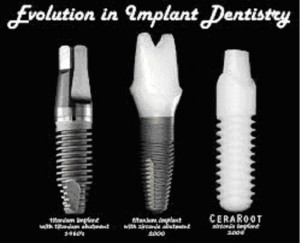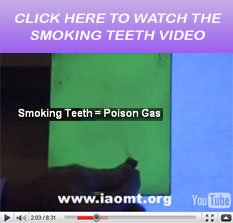Zirconia Dental Implants
 Dr. Christopher Tsang is one of the few dentists in North America offering the Ceraroot Zirconia Dental Implant system.
Dr. Christopher Tsang is one of the few dentists in North America offering the Ceraroot Zirconia Dental Implant system.
Patients are travelling from long distances to take advantage of this leading edge technology.
Zirconia is not a metal, it is a white ceramic material that has various advantages over titanium in certain clinical situations.
Here are 10 differences between metal-free Zirconia Dental Implants and conventional metal (titanium/titanium alloy) implants.
1. Biocompatibility:
Zirconia is a very biocompatible material and because of that a very firm fixation occurs between the bone and the ceramic implant. A study performed in the University of Minnesota confirmed the strong osseointegration (rigid fixation to bone) of CeraRoot implants. The microscopic histological images confirmed a direct contact between the bone and the implant surface without any signs of inflammation or foreign body reactions. Many other scientific publications have reported similar results, confirming that zirconia is an excellent material for dental implants.
2. Allergies & Sensitivities:
There is an increasing number of people that present with allergies, sensitivities and other skin or immune system reactions that may contraindicate the implantation of a metal device into the body. Most of the cases of titanium implant allergies are developed after long-term exposure with the metal. This means that although the patient may not have an allergy or sensitivity on the day of surgery, the patient may develop the allergy after some years of direct contact and exposure with the metal. This allergy may cause itching, redness, discomfort and inflammation that may lead to bone loss around the implant. Because removing a titanium implant from a jaw bone is not a simple procedure, it is recommended to have specialized allergy testing prior to the implant placement to see if there is any sign of allergies, skin sensitivities and any other immune system reactions.
3. Esthetics:
Zirconia implants are white in color and thus overcome many shortcomings of the metal titanium implants. This is especially important in patients with thin gums, where the metal implant may shine through the gum tissue giving a grey appearance. Moreover, the aging process is sometimes associated with recession of the gum and the metal of the titanium implant may become visible in the mouth.
4. Corrosion resistant:
Zirconia implants are more biocompatible than titanium implants. Zirconia is resistant to chemical corrosion and it is an electric and thermal insulator. These three properties make zirconia a bio-inert material and thus the surrounding tissues around the implants are totally healthy.
5. Electric insulator:
The non-electric conductivity of zirconia makes it more difficult for bacteria to adhere to the surface of the implants and thus, it is more easy for the patients to clean and maintain healthy gums and avoid bleeding of the tissues.
6. Holistic friendly:
CeraRoot implants do not alter the body’s energy meridians. For those patients who follow the principles of acupuncture meridians in holistic medicine, zirconia implants are the best solution because they are totally bio-inert.
7. Strength:
The long term success of the CeraRoot implants is the most important aspect of the system. The implants have been designed to withstand the masticatory (chewing) forces of the mouth. The CeraRoot zirconia implant’s function is to replace specific teeth in the mouth in the most biological manner. For this reason both the diameter and length are similar to those of natural teeth.
8. One-piece design:
The traditional titanium implants systems consist of an implant which is placed at bone level and the abutment connection that is connected to the implant by means of a fixation screw. With the one-piece design of CeraRoot zirconia implants the aspect of the tissues around the one-piece implants resembles very much that of the natural dentition.
9. One-stage surgery:
The CeraRoot implant placement is done in a one-stage approach. The implants are specially designed for the immediate placement after a tooth extraction. Moreover a minimal invasive surgery may be possible in cases with no infections and sufficient bone where the implant may be placed transmucosally (through the gum) without having to make incisions and suture the gums.
10. Comfort:
Because all of the above reasons, the surgical procedure is simplified, the healing is often uneventful and the result is as natural as a tooth. The CeraRoot implant is in fact an ideal tooth replacement.

